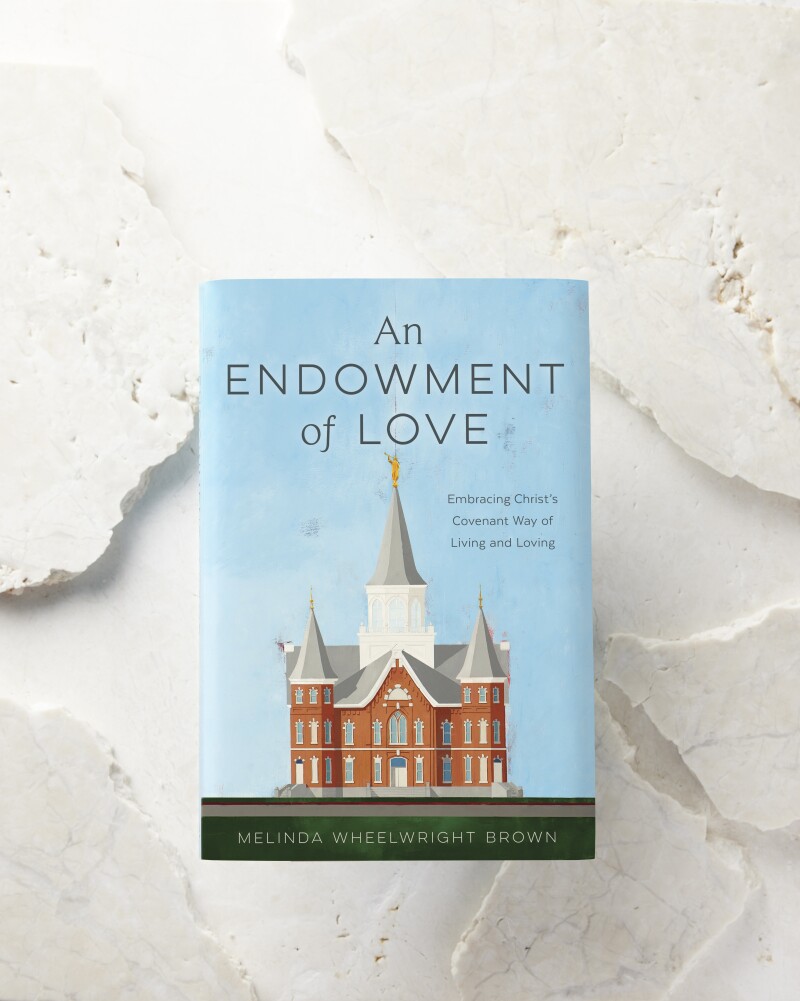Editor's note: The following is an excerpt from An Endowment of Love, a new book by Melinda Wheelwright Brown.
What makes a house a home? Though it may seem cliche, home is where the heart is. We can personalize our own descriptions of what constitutes a loving home by adding our favorite adjectives, like tender, gentle, generous, warm. The list could go on and on as we flesh out the feelings and emotions of home. Let’s paint a bigger picture of that precious sense of heartfelt belonging that humans crave.
If we could cozy up in front of a fire and share our favorite memories of the nostalgic smells, sounds, and sights that have become our unique beacons of love and belonging, a common feeling might emerge: comfort. Those physical, sensory-infused evidences of security in a place that feels familiar, safe, and comfortable sink in deep and stay with us.
Such lasting memories suggest that an ideal starting point for approaching the house of the Lord is recognizing it as a place of love and belonging. Since we might be less familiar with some elements of temple worship, having these two footings firmly in place will provide a secure base on which we can build. Let’s turn to scripture to try to better understand how the Lord loves us.
In his letter to the Romans, the Apostle Paul captured the intense depth and reach of the Lord’s relentless love for each of us by posing two poignant questions: “Who shall separate us from the love of Christ? Shall tribulation, or distress, or persecution, or famine, or nakedness, or peril, or sword?” (Romans 8:35). His answer is powerful as he passionately testifies based on his own experiences: “Nay. . . . Neither death, nor life, nor angels, nor principalities, nor powers, nor things present, nor things to come, nor height, nor depth, nor any other creature, shall be able to separate us from the love of God, which is in Christ Jesus our Lord” (Romans 8:37–39).

Expounding on God’s love for us, President Thomas S. Monson echoed Paul’s assuredness, declaring, “Your Heavenly Father loves you—each of you. That love never changes. It is not influenced by your appearance, by your possessions, or by the amount of money you have in your bank account. It is not changed by your talents and abilities. It is simply there. It is there for you when you are sad or happy, discouraged or hopeful. God’s love is there for you whether or not you feel you deserve love. It is simply always there.”1
I hope you’ve had personal experience with love like that; perhaps you remember a family member, friend, mentor, or teacher who loved you whether you were happy or sad, mad or glad. For me, that person was my grandmother. Instead of pointing out my deficiencies, she highlighted my strengths.2 When I spent time with her, I was always better for it; I’d leave her presence as the best version of myself.
That kind of relationship is fueled by the type of love President M. Russell Ballard was describing when he noted that, ideally, “It is within our families that we learn unconditional love, which can come to us and draw us very close to God’s love.”3 While our families may strive and struggle to reach this ideal, each does so uniquely, with various degrees of success and satisfaction.
It’s reassuring to remember what Sister Tamara W. Runia pointed out. “In a fallen world there’s no way to be a perfect spouse, parent, son or daughter, grandchild, mentor, or friend—but a million ways to be a good one.”4 Though no family is perfect, the family structure was designed to provide both a place to practice loving well and a place to feel safety, peace, and rest.
In the Old Testament, the Hebrew word frequently translated as “rest” (menuhah) tries to capture this “deep sense of belonging, of security.”5 For example, in Deuteronomy 12:9, as the Lord is teaching the children of Israel about the blessings that will flow from their covenant relationship with Him, He describes the “rest” that will accompany their “inheritance.” Bible scholar Ellen Davis describes this kind of rest as “the unshakable assurance that a person or a people feels in the presence of God, even when enemies threaten.” She goes on to describe this kind of peace as “the blessing of God’s favor and continual presence, which gives freedom from the sources of deepest anxiety.”6
That description dovetails beautifully with President Dallin H. Oaks’ definition of abide, another word frequently used in scriptures to characterize that sense of feeling at home. He defines it as “a secure placement.”7 As the lyrics of the pleading hymn “Abide with Me!” longingly express, “When other helpers fail and comforts flee, Help of the helpless, oh, abide with me!”8 It’s therefore fitting that abide is so closely related to the word abode, a synonym for house or home.9 When we feel at home in a place, we feel a deep sense of security and belonging based on unchangeable, unshakable, inseparable love—the kind of love God has for each of us.

This connection informs how it is equally accurate to say you feel “at home” in a place as it is to say you feel “at home” with a person. That sense of comfort is a function of both being in your grandmother’s house and being with your grandmother. Though I can close my eyes and easily recall the smell of my grandmother’s kitchen, that spicy-sweet scent reminds me more of her than of her oatmeal raisin cookies. That’s because those tender feelings are all about our relationship—they stem from the fact that she is my grandmother, and I am her grandchild.
Relationships are the primary source of our secure sense of love and belonging. Our layers of identity generally derive from our relationships; they remind us of both who we are and whose we are. That’s why understanding our divine identity and our inherent relationship with the Lord is so crucial to feeling at home in His holy house. As President Russell M. Nelson has testified, “In all of eternity, no one will ever know you or care about you more than He does. No one will ever be closer to you than He is.”10 President Nelson has repeatedly urged us to “know the truth about who [we] are. . . . [We] are literally spirit children of God.”11 While it’s certainly true that we have many layers of identity, some of which come and go over time, no characteristic matters to the degree that our divine heritage does. None offers us such a clear vision of who we can ultimately become. God longs to give us “glimpses of who [we] may become.”12 Once we gain our own witness of this glorious truth, and then begin to familiarize ourselves with His sacred house, we naturally begin to feel at home there because we long to be with Him.
In addition to providing divine guidance and direction individually, our loving relationship with the Lord also has the power to bless all our other relationships as well. One of the benefits of spending time with my grandmother was that with each visit I gradually became more like her. Her kindness was contagious; she showed me what generous, unconditional love felt like, and the more deeply I felt it, the more I desired it, and longed to share those feelings with others that I loved. Time spent with the Lord, especially in His holy house, can do the same.
Just as my grandmother was the heart of her home, the Lord Jesus Christ is “the beating heart of the eternal gospel,”13 and the love and belonging we are invited to feel in His house flows from our most sacred relationships—“the love of Heavenly Parents, the atoning gift of a divine Son, [and] the comforting guidance of the Holy Ghost”14—and from there into all of our other relationships. As President Jeffrey R. Holland put it, like so much of life, our temple experience “will mean little or nothing unless we find Jesus at the center of it all.”15 Home is, indeed, where the Heart is.
An Endowment of Love
More articles for you:
▶ The general conference quote that changed how I approach the temple
▶ When the name you ‘take’ to the temple becomes a real person
▶ The initiatory ordinance is beautifully relevant to daily life—here’s how
Notes
1. Thomas S. Monson, “We Never Walk Alone,” Ensign, November 2013.
2. The Prophet Joseph Smith shared his personal experiences with this influential character trait, declaring: “Nothing is so much calculated to lead people to forsake sin as to take them by the hand and watch over them with tenderness. When persons manifest the least kindness and love to me, O what pow’r it has over my mind, while the opposite course has a tendency to harrow up all the harsh feelings and depress the human mind.” Joseph Smith, Jr., address to the Nauvoo Female Relief Society, 9 June 1842, “Nauvoo Relief Society Minute Book, 62, The Joseph Smith Papers, https://www .josephsmithpapers.org/paper-summary/minutes-and-discourse-9-june-1842/2.
3. M. Russell Ballard, “Let Our Voices Be Heard,” Ensign, November 2003.
4. Tamara W. Runia, “Seeing God’s Family through the Overview Lens,” Liahona, November 2023.
5. Ellen Davis and Margaret Adams Parker, Who Are You, My Daughter? (Louisville: Westminster John Knox Press, 2003), 19. See Brown-Driver-Briggs Hebrew and English Lexicon, 629.
6. Davis and Parker, Who Are You, My Daughter?, 19.
7. Dallin H. Oaks, “Kingdoms of Glory,” Liahona, November 2023.
8. “Abide with Me!” Hymns of The Church of Jesus Christ of Latter-day Saints, no. 166.
9. Oxford English Dictionary, “abode.”
10. Russell M. Nelson, “Choices for Eternity” (worldwide devotional for young adults with President Nelson, 15 May 2022), https://www.churchofjesuschrist.org/study/broadcasts/worldwide-devotional-for-young-adults/2022/05/12nelson?lang=eng
11. Nelson, “Choices for Eternity.”
12. Nelson, “Choices for Eternity.”
13. Jeffrey R. Holland, “The Message, the Meaning, and the Multitude,” Ensign, November 2019; see also Russell M. Nelson, “The Temple and Your Spiritual Foundation,” Liahona, November 2021.
14. Holland, “The Message, the Meaning, and the Multitude.”
15. Holland, “The Message, the Meaning, and the Multitude.” President Holland further expounded on this important principle, stating, “When one goes to the holy temple for the first time, he or she may be somewhat awestruck by that experience. Our job is to ensure that the sacred symbols and revealed rituals, the ceremonial clothing and visual presentations, never distract from but rather point toward the Savior, whom we are there to worship. The temple is His house, and He should be uppermost in our minds and hearts—the majestic doctrine of Christ pervading our very being just as it pervades the temple ordinances—from the time we read the inscription over the front door to the very last moment we spend in the building. Amid all the wonder we encounter, we are to see, above all else, the meaning of Jesus in the temple.”



